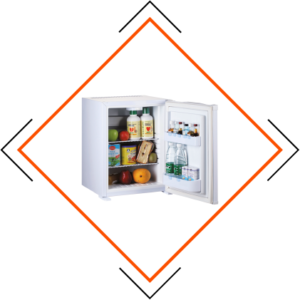The two most popular technologies on the market for minibars are thermoelectric technology and absorption technology.
Each technology offers features that suit particular needs. In order to choose the best minibar model and obtain the best results, it is essential to know them.

What is the difference between absorption minibars and thermoelectric minibars?
Absorption technology
Like the compression cycle, the absorption refrigeration cycle is based on the idea that the fluid acting as a refrigerant must absorb heat from the liquid being cooled to pass from the liquid state to the vapor state, lowering the pressure to which it is subjected. The fluid in the liquid state in refrigeration equipment is at a higher pressure in the condenser and is forced to flow to the evaporator at a low pressure where it absorbs the heat necessary for evaporation from its surroundings. The heat gained by returning to the liquid state is subtracted from this refrigerant when it returns at high pressure to the condenser to restart the cycle. This achieves the objective of removing heat from one zone, the evaporator, cooling it and dispersing it in another, the condenser.
In the compression cycle, a mechanical compressor is used to circulate the fluid and create pressure. In the absorption cycle, heat is applied to the generator, where the refrigerant is combined with an absorbent. The latter acts as a fluid whose purpose is to absorb the vapor in the low-pressure zone and return it to the generator in liquid form.
If we apply this technology to minibars, it makes them the quietest system on the market. They are ideal for places with moderate temperatures, making use of chemical and physical refrigerants.
With automatic defrosting and intelligent thermostat with interior temperature sensor – in order to maintain a constant interior temperature – Simex minibars equipped with this technology represent a significant energy saving for hotels or establishments. In addition, they are equipped with height-adjustable trays, a bottle separator and a low interior LED light.
Our models have reversible doors, which means a great adaptability to the space and are available in different capacities (30L and 40L) as well as in different finishes (white and black).

Thermoelectric technology
Thermoelectric technology (the Peltier effect) can be used for cooling a variety of products. From industrial cabinets to portable refrigerators to mini-bars it provides a number of significant advantages in certain applications. Modern technological advances have greatly increased the effectiveness and efficiency of thermoelectric coolers since their inception some 200 years ago.
Simply put, thermoelectric refrigeration reduces the temperature of cabinets to ambient or near ambient levels by using an electric current flowing through semiconductors to facilitate the temperature change.
Camping enthusiasts frequently use Peltier devices to cool electronic parts and tiny instruments, as well as for portable refrigerators. Thermoelectric cooling is also used to cool some electronics intended for military combat use. The temperature can often be reduced to as low as 20oC with an electric cooler. More complex units, incorporating a small fan, have a higher cooling capacity and are ideal for larger devices.
In short, this is cooling by applying electric current to two semiconductor elements that absorb heat on one side and emit cold on the other, aided by a low-power fan.
Regarding the use of this technology in minibars, it provides them with a silent and energy-saving system. Simex minibars incorporate auto defrosting, internal LED lighting and are particularly environmentally friendly.
Our range of thermoelectric minibars incorporates the minibar ref 08086 in black finish and glass door, whose design allows the products it contains to be constantly in sight and encourages its consumption by the guest.

Tips for installation and maintenance of minibars
The minibar should be placed on a solid, flat surface, away from heat sources (sunlight, hot surfaces), away from humid areas.
The refrigeration systems, which are located at the rear of the minibar, should be well ventilated in order to remove the heat they produce. Air circulation – from its inlet at the bottom of the minibar to a top outlet where the hot air is expelled – is necessary.
In order to ensure optimum ventilation, the installation instructions for each minibar model must be observed. In the same way, the indicated distances between the minibar and the surface on which it will be installed must be respected: 6 cm at the sides, 12 cm at the top and 11 cm at the bottom. Since ventilation can be problematic, it is important to maintain the safety distances mentioned above. Also, if possible, to place a front grille in the cabinet door to ensure that the heat generated is vented to the outside when a minibar is installed in a cabinet.
Electrical circuits may be adversely affected if the minibar is installed without regard to these ventilation gaps. This would reduce efficiency and increase daily consumption, preventing optimal operating conditions.
Maintenance and efficient use of energy
It is advisable to clean the minibar frequently to ensure proper maintenance. Particularly if it is a thermoelectric minibar with fans, cleaning should be regular, otherwise its operation could be compromised.
Before cleaning, it is of vital importance to unplug it. In the same way, it should be emptied and the trays removed. To clean the interior, a damp cloth is sufficient. We advise you to avoid aggressive chemical products.
On the other hand, to ensure efficient and constant operation and cooling, the minibar should not be overfilled. It should also be noted that the minibar will consume less energy in a cooler environment.
It should be noted that these indications are generic and that, to ensure the correct operation of any minibar, as well as the lowest possible energy consumption, all installation and maintenance instructions specific to each model provided by the manufacturer should be followed.




